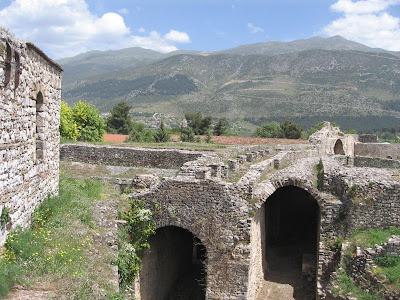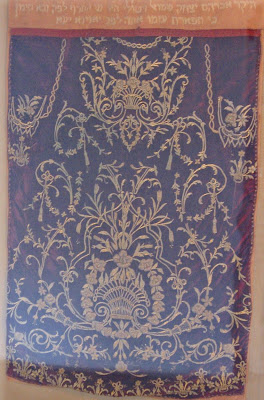Wednesday 21st May 2008, Ioannina
Yesterday we drove from the island of Lefkada to Ioannina in the mountainous, isolated, inland region of Epirus. Our journey took us across the coastal plains and through a long tunnel beneath the sea across the mouth of the Amvrakikos Gulf. We passed the massive Roman monument to the victory of Augustus at the naval battle of Actium in 31BC and continued up the Louros gorge. At Ioannina we found the campsite prettily set on the lakeside with high grey mountains on the far side. From somewhere high up there the lights of an isolated village seemed to shine down from the sky at night. This site is only two kilometres from the busy town centre but it is peaceful and very pleasant. There are grebes with their young bobbing on the water and frogs chorusing and carousing at night. We are very fortunate to have discovered the existence of a campsite here as inland Greece has very little to offer and it is too far for us to travel from the coast to Meteora in a day.
So although we originally came here as somewhere to overnight, we have discovered it has a very great deal to offer. It is just a short drive from the border with Albania and it is only in the 20th century that the region of Epirus became part of Greece having formerly been part of the Ottoman Empire, governed by Ali Pasha who later broke away from his Turkish overlords, claiming the region as his own.
This morning we walked into the town. It is clean, bright and friendly. It boasts its own university and is famed for its exquisite silverwork. In the modern town there are souks and street stalls selling modern silverware and jewellery, some exquisite, some less so. The Turkish influence here is very strong. Souvenir stalls are crammed with hookahs – long tubes for inhaling smoke through scented water. There are Turkish style earrings, bracelets, rings and necklaces. There are Turkish variations on worry beads. Small shops in side streets sell dried fruit, nuts, halva and loukoum (Turkish delight). Bakers' shops have windows filled with sweet, sticky, Turkish sweetmeats. There are several mosques and minarets around the town, though they are no longer used. Unpopular as the thought may be in Greece, it is obvious there is still a very strong Turkish legacy in this region of the country. However, during much of the Ottoman occupation and the control by Ali Pasha, the Greek Christian and Jewish communities seemed to have co-existed reasonably well with their Turkish overlords and the silversmiths certainly flourished.

The citadel lies on the lakeside with a second fortress within. Inside the high stone walls it is a haven of peace and calm compared to the noisy bustle of the modern town outside the main gateway. It is now almost exclusively a residential area.


We followed the streets up to the inner fortress. Here there are impressive views down onto the lake and the surrounding mountains where snow still remains. Here are the ruins of the former Seraglio (harem) of Ali Pasha. There is also a museum housing Byzantine sculptures and colourful, mainly 17th century icons. Nearby are a former powder magazine and a minaret from where the Turkish imam would call worshippers to prayer.



Ali Pasha was born in Albania in 1741. He was installed as Pasha of Epirus in 1788. He governed the area with a great deal of autonomy, extending his control and growing ever more powerful. Eventually he separated himself from Turkey, claiming the region in his own right. His Turkish masters sent forces to overthrow him. In 1822 he was eventually chased from the city to a nearby island where he was caught and killed. His decapitated body lies in a grave with an open ironwork cover in the inner citadel.

Within the outer fortifications we found the municipal museum housed inside the mosque of Ali Pasha complete with its minaret. Having visited several mosques in Bosnia last year we were familiar with their interiors. It was good to see that it was well preserved and respect paid to its original purpose despite the general distaste for all things Turkish in Greece. It is rather more than the Ottomans did when they overran Ioannina back in the 15th century. Then they destroyed many Christian churches and imposed their own mosques, thus proving their domination. Now the museum tries to represent all the religious cultures in its exhibits, Christian, Jewish and Arab. There are some beautiful examples of Turkish furnishings and enamelled silverware, as well as traditional Greek costumes and religious accoutrements from the synagogue.




Nearby there is a weaponry of Turkish swords, sabres, scimitars, and guns. Looked at from the distance of time, purely as works of art, they are beautiful. The guns and rifles have silver filigree ornamentation while the shape of the sabres with their curved blades is aesthetically satisfying. Personally however, such exhibitions fill me with mixed feelings of awe and distaste that so much effort, skill and craftsmanship can go into producing something intended to maim and kill fellow humans, frequently simply because they hold different beliefs! The faded 19th century pictures of the fighters gave an insight into the culture of the time with the Greeks wearing white skirts, leggings and shoes with pompoms while the Turks wore turbans and shirts with voluminous sleeves. They were both festooned with knives, daggers, guns and curved swords dangling from leather cords around their waists.
Nearby we found the remains of a Turkish cemetery with some beautiful headstones. Also within the citadel is the Jewish synagogue, unfortunately locked and seemingly disused. During mediaeval times there was a high Jewish population in Ioannina. At the outbreak of the second World War their number had dwindled to a couple of thousand. Most were sent to die in concentration camps and by the end of the war less than 170 remained. Today there are only around 50.

Having spent a long morning in the citadel we made our way down past the remains of the old Turkish library to the town for lunch – a spinach pie affair on a shady bench.

Down on the lake a ferry was leaving for the island of To Nisi where Ali Pasha hid from his Turkish masters when they came to kill him. Fifteen minutes later we were walking the tiny island quay with its souvenir shops and several fish restaurants. The fish were all displayed in huge tanks standing between the dining tables. All came from the lake. There were tanks packed with metre long eels with no room to swim or turn. Amongst their long bodies scrambled fresh water crayfish, feeding on the skin of the eels. Other tanks contained large fresh water fish. Most visitors to the island content themselves with staying around this little village as there is no transport allowed. Not Ian however. He was determined to walk right around the island. Fortunately it was neither too large nor too hilly. In fact it was a charming walk offering lovely views back to the shore and providing a haven for wild life with water fowl in the reeds and colourful wild flowers crowding the tiny island path. These encouraged a plethora of insects and butterflies. The large purple thistle heads in particular attracted huge gentle bees many times larger than we have seen elsewhere in Europe. There were, even on this small island, many lizards, including the large green one that is native to the Balkan countries.



The island has several prettily set monasteries though all were closed as we walked by. We found the reconstructed building where Ali Pasha was hunted down and killed but somehow it didn't seem worth paying a couple of euros to see the bullet hole in the floorboards, particularly as we had read elsewhere that he was decapitated.


So we took the ferry back to explore more of the modern parts of Ioannina and to find an internet place before returning to sit by the lakeside outside Modestine with glasses of wine.

